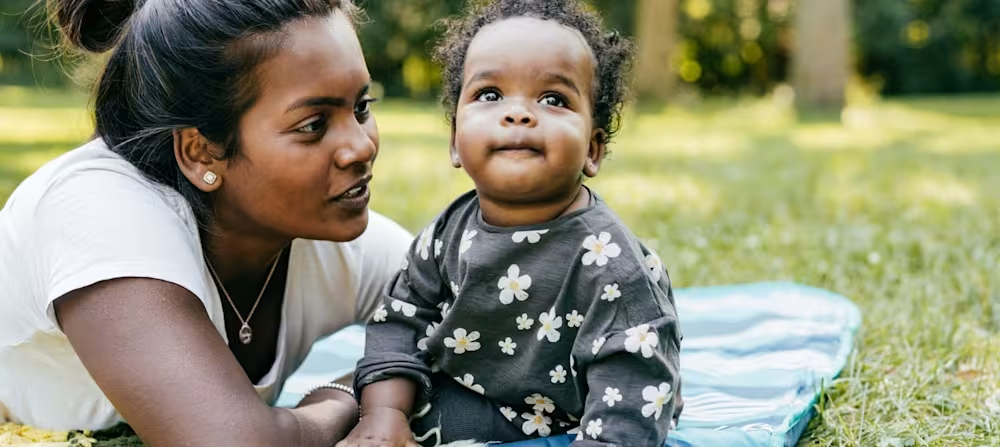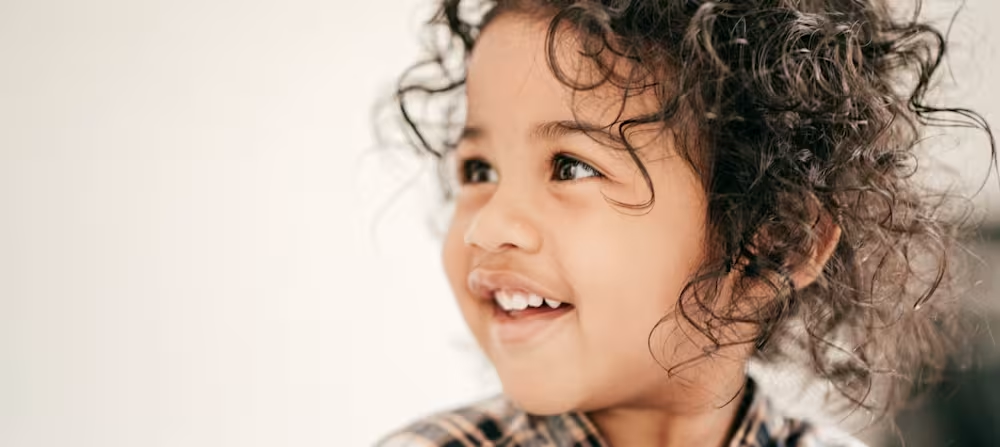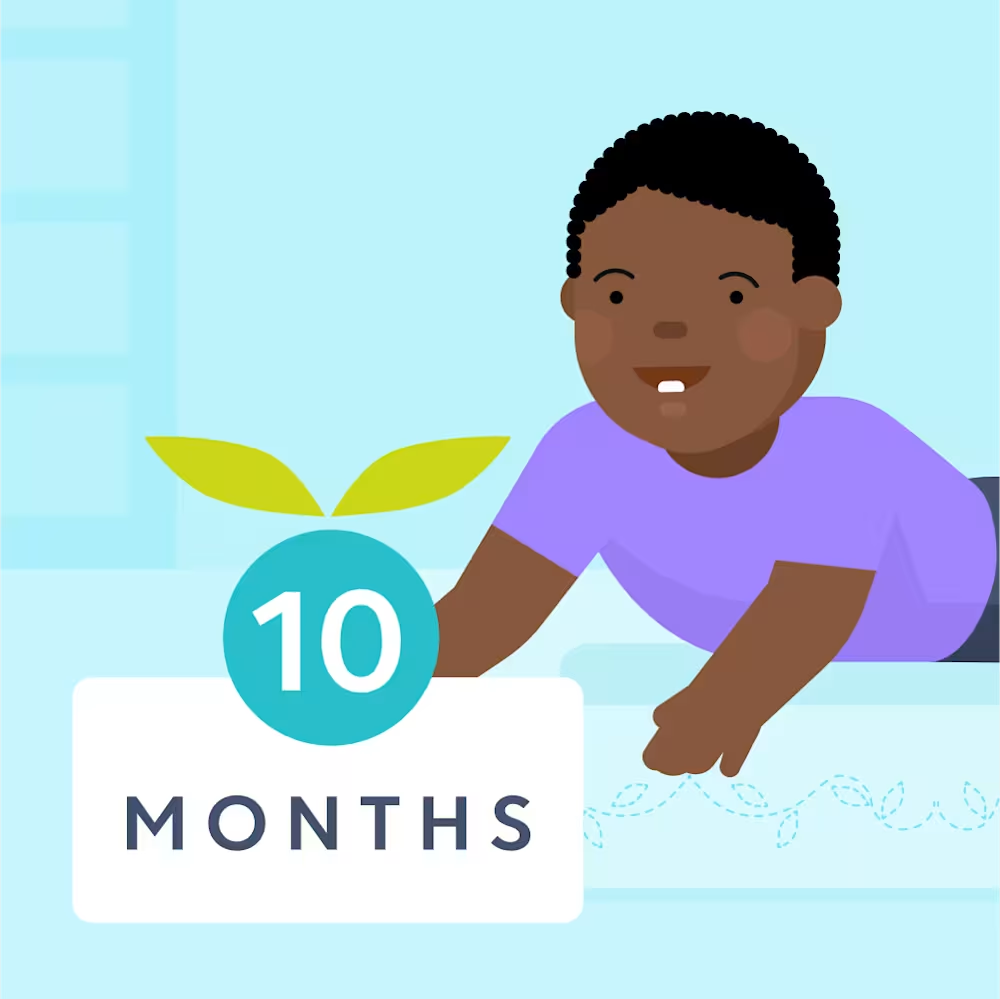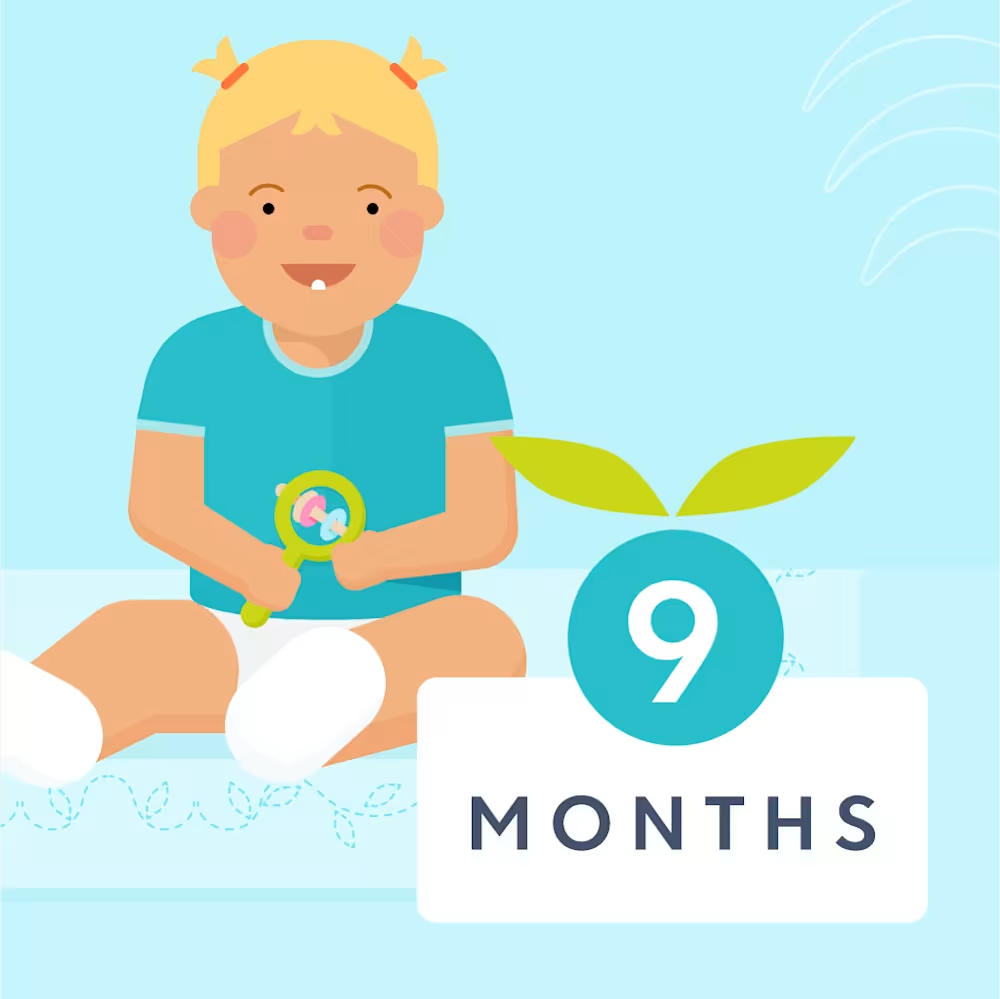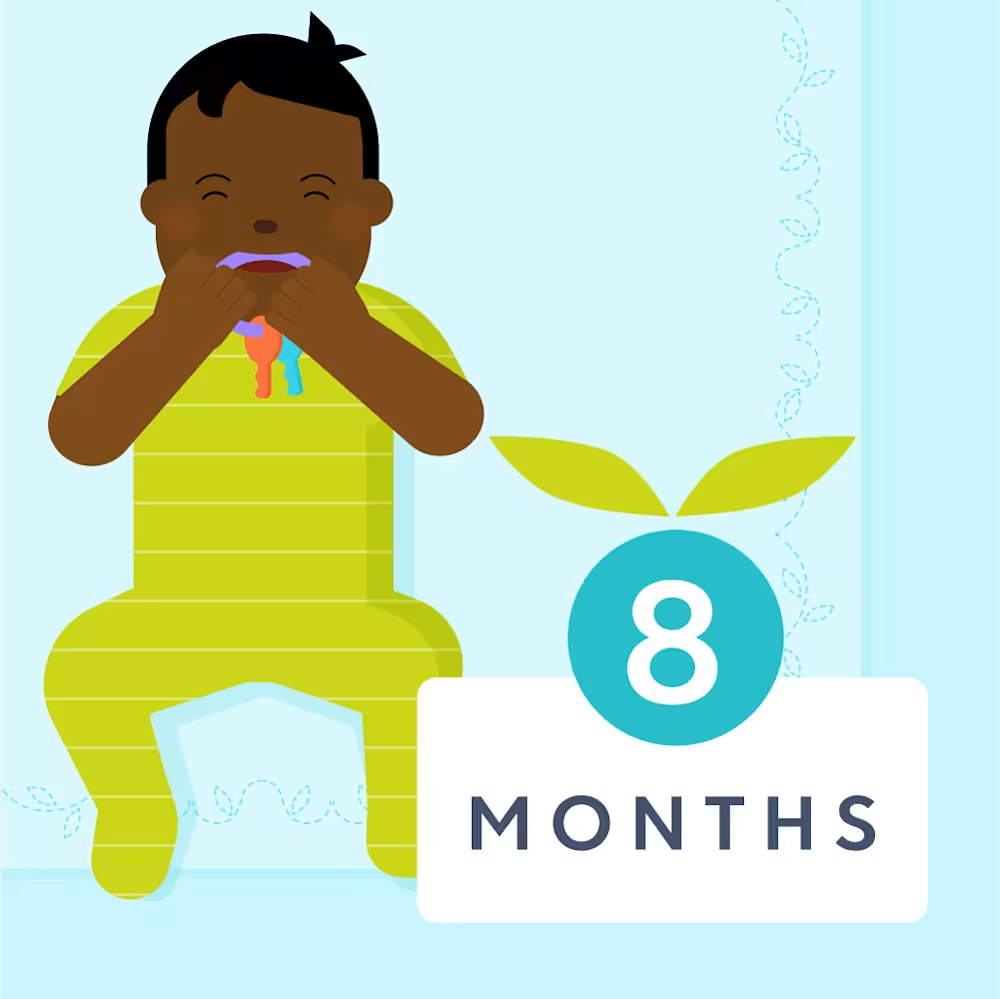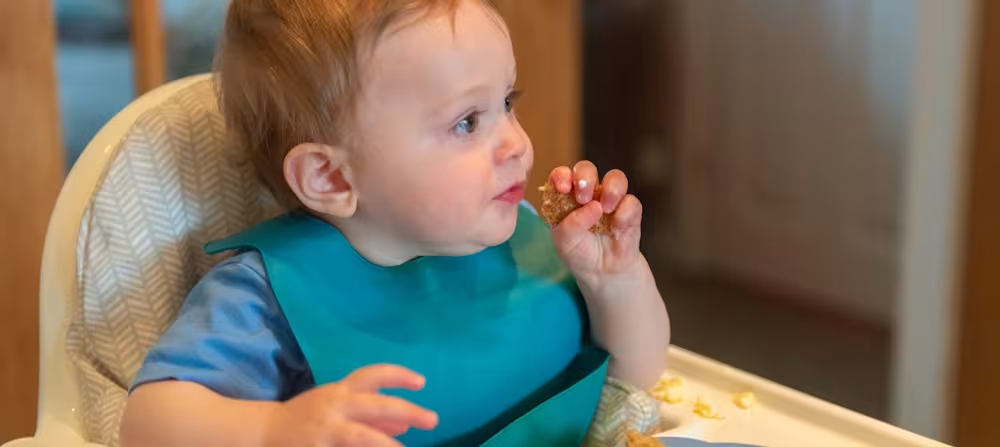9 month old baby milestones: Development, growth, speech, language
Updated Oct 17, 2025

Babies at 9 months are in a bit of a limbo stage where they’re not quite tiny babies but they’re not yet toddlers. They’re showing emotions, babbling, and moving around so much more these days, however, they still have a ways to go before they’re walking, talking toddlers. It’s a fun stage of development and there are plenty of exciting ways 9 month olds learn and grow.
In this article, we’ll take you through the milestones you can expect from 38 - 42 week old babies, give you a handy 9 month old development checklist, and provide useful tips to help ensure your little one is learning and growing as much as possible.
Editor's note
When we discuss babies and development at Huckleberry, we use their adjusted age (vs. actual age). Not all babies will reach 9 month old milestones simultaneously — and that’s OK! There’s a wide range of normal when it comes to how fast babies grow and develop. While many infants do reach these milestones between 38 and 42 weeks, this isn’t always the case. If you have any concerns or questions about your child’s development, reach out to their pediatrician.
Table of Contents
9 month old baby milestones at a glance
Development:
Around 9 months, most babies are gaining some independence thanks to their developing gross motor skills. Typically they’ve started moving on their own by doing some version of creeping or crawling (though some babies never crawl!). They’re able to use new fine motor skills to do things like to feed themselves by picking up pieces of food with their thumb and index finger.
On the language development front, they’re better able to show emotions and may be able to connect meaning to words like “mama” and “dada” at this age.
Sleep:
around 14 hours of total sleep over 24 hours at this age. This sleep is usually broken down into 11 - 12 hours of overnight sleep and 2 - 3 hours of daytime sleep split over 2 naps. At 9 months, most babies can comfortably stay awake between 2.75 - 3.75 hours before sleeping again. These suggestions offer a basic framework for 9 month old sleep. It’s also helpful to pay attention to your child's mood and energy levels when evaluating their individual sleep requirements.
Around this time it’s common for babies to hit a period of challenging sleep AKA the (also called the 9 month sleep regression). This temporary phase is characterized by short naps, difficulty getting to sleep, and more frequent night wakings where time awake can last for long periods. If your child is experiencing these sleep challenges, rest assured that it won’t last forever! Sleep regressions typically last for 2 - 6 weeks.
However, it's also usual for families to develop new routines during this time as a way to manage this phase — routines that frequently carry the risk of disturbing sleep over extended periods. For example, if a child who was able to fall asleep on their own starts requiring rocking to sleep, this change can frequently lead to more instances of waking up during the night. Fostering better sleep habits can help reset a baby's bedtime routine expectations, and return to encouraging your little one to fall asleep on their own once again. Many parents choose to accomplish this through .
Feeding:
Babies at 9 months , whether it’s breast milk, formula, or a solid food meal. At this age, most of your baby’s nutritional needs are still coming from formula and breast milk even as more solid food meals are incorporated into their daily routine. Your baby’s typical day may include 2 - 3 solid food meals as well as 3 - 5 nursing sessions or bottles.
Around 9 months your baby can move toward eating finger foods [] as their hand-eye coordination has improved as well as the fine motor skills that help them pick up small pieces and feed themselves. They can also benefit from trying advanced textures as they become more confident eaters. offering liquid feeds at least 30 minutes before solid food to make sure your baby comes to the table hungry and is getting the nutrition they need.
At this age, a baby's appetite may vary quite a bit. Factors such as teething can impact how much they eat, especially when it comes to solid food. If this is the case, they may prefer breast milk or formula for a few days and that’s OK! If you have concerns about your child’s eating patterns, consult their pediatrician.
Growth:
Most babies have a weight gain [] of about .5 - 1 pound each month at this age. They may grow about .5 inches in length too. Head size typically increases by about .25 inches each month as well.
Note that it can be normal for your little one to grow more or less than this between 38 - 42 weeks. At well-baby visits, your child’s doctor will chart their physical growth to check that they’re growing at a regular pace and can pinpoint any trends that need attention.
9 month old development milestones
Physical development
Gross motor milestones
Sitting transitions: By around 9 months, most babies are able to get in and out of a sitting position [] on their own while on the ground. Being able to change positions on their own helps strengthen the muscles needed to then move from sitting to a crawling position.
Creeping/crawling: Most babies crawl between 7 - 10 months [], so at 9 months your baby is likely doing some version of creeping or crawling! There are many like classic hands-and-knee crawling, belly crawling on elbows, bear crawling with outstretched hands and feet, bottom scoot crawling, etc.
Editor's Note
Some babies never crawl. Babies who don’t crawl (or who have a crawling style other than classic) can still reach subsequent motor milestones like walking. However, if you’re concerned about your baby’s gross motor development, reach out to their doctor.
Pulling to stand: 9 month old gross motor milestones usually include babies working on pulling themselves up [] into a standing position using a sturdy piece of furniture for support (like a couch or step stool). They may also start to take steps [] while continuing to hold onto said piece of furniture. This action is called cruising and is a precursor to walking.
Fine motor milestones
Pincer grasp: Babies can typically use their hands in new and exciting ways by around 9 months. A baby’s pincer grasp [] (use of thumb and index finger together) usually develops at about this time, making it easier for little ones to do things like pick up small toys and feed themselves. Most babies can poke something with their pointer finger at this age too.
Holding objects: Around 9 months, babies are becoming more self-sufficient when it comes to eating. Most little ones can hold a bottle themselves [] and will try to hold a spoon when they’re eating. It might be pretty messy at first, but it’s a big deal that they’re able to try! Another expected 9 month fine motor milestone is being able to bang two objects together [].
Speech development
Connecting meaning to babbles: Your baby may have been babbling “mama” and “dada” [] for a couple of months now. But until around this time, they probably didn’t connect any meaning to the words — they were simply sounds. Now, at around 9 months, your little one may know what the words “mama” and “dada” mean, if those are terms you use in your family. This is one of the milestones you’ll likely remember forever!
Early language comprehension: Your baby is likely understanding some simple instructions [] at this age, especially when you use visual cues to help them — like motioning with your hand when you say “Come over here!” They also might look for familiar objects when you name them out loud.
Copying movements and sounds: At 9 months, you may notice your little one is copying movements [] they see and also mimicking sounds they hear. For example, if you push a button on a toy, they may then push the same button on the toy. When your child imitates you, it means they are paying attention and learning from you!
Social development
Emotional development
Expresses feelings: Typical 9 month old emotional development includes showing their feelings [] using facial expressions and actions like crying, pointing, smiling, frowning, etc. Even though they don’t yet have the words to verbally express their emotions, they can still “say” a lot this way.
Separation anxiety: If your baby is suddenly extra clingy and gets upset when you leave the room, may be the culprit. Separation anxiety usually starts around the 9-month mark. It’s a normal phase of brain development that marks a shift in your child’s understanding of themselves in relation to caregivers. When your baby realizes they are not physically connected to you, it’s often anxiety-inducing.
Things like taking extra time to introduce your baby to a new caregiver or environment can be useful in proactively handling this period of development. The period of separation anxiety usually ends around 18 months so rest assured it won’t be forever.
38 to 42 week old development milestones checklist
Most children will hit the following milestones by 38 - 42 weeks, but this might not always be the case. Babies develop at different rates and there’s a large spectrum of normal regarding how fast a baby grows and learns. If you are concerned about your little one’s growth or developmental delays at 9 months, reach out to their healthcare provider.
Gets in and out of sitting on their own
Creeps/crawls (note some babies never crawl!)
Starts to pull to stand
May take steps while holding onto support (cruising)
Picks up small objects with thumb and index finger (pincer grasp)
Tries to hold a bottle or spoon while feeding themselves
Connects meaning to babbled words like “mama” and “dada”
Understands simple instructions like “come here,” especially when coupled with a gesture
Copies of movements and sounds
Shows feelings with facial expressions and gestures
Displays signs of separation anxiety
What are 9 month old development red flags?
At 9 months, there's a range of normal — all babies develop on their own schedule! However, there are a few signs to bring up with your pediatrician if you notice them. Check in with your pediatrician if your baby []:
Unable to support weight on legs even when assisted
Unable to sit upright even with assistance
Not babbling sounds like “mama,” “baba,” or “dada”
Shows no interest in interactive, back-and-forth play
Does not react when their name is called
Does not appear to recognize familiar faces
Does not follow your gaze or look toward where you’re pointing
Does not move toys or objects from one hand to the other
3 development tips for 9 month old babies
Tip #1: Talk to your baby
Chatting with your little one every day is a great way to help them reach 9 month language milestones and improve cognitive development. Exposing your child to as many words as possible and engaging in back-and-forth “conversations” help your baby learn [] and become more interested in speech. Also, try to respond to your child’s babbling so they feel engaged with you too.
Tip #2: Encourage movement
If your baby is working on some version of creeping or crawling at 9 months, you can encourage their gross motor skill advancement by getting on the floor with them. Place toys a little out of reach to encourage their movement (and problem-solving!) and even try a very simple game of hide and seek.
Note that some babies never crawl and that’s OK. Meet your little one where they are developmentally and encourage them to do activities that build muscle strength that will help them with future motor skills like standing and walking.
Tip #3: Introduce new caregivers and experiences slowly
At 9 months, babies often and may cry and become upset when you bring them to a new place and/or leave them with a new caregiver. To help build your child’s trust and learn how to tolerate being away from you, try gradually introducing your little one to these new situations. This may look like leaving them with a new caregiver for a short period at first then increasing the time once they’re more comfortable.
Activities for a 9 month old baby
1. Level up reading
Encouraging your little one's curiosity and love for books is great for 9 month old language development. You can help foster their interest in reading by choosing board books with simple stories. Rhymes and repetition [] also often do a good job of capturing the attention of little readers — as do books with pictures of other babies in them!
2. Let your baby feed themselves
When your baby has developed a pincer grasp and can feed themselves, encourage them to self-feed as much as possible. Allowing kids to use their fingers to eat helps them develop healthy, independent eating habits []. Note that babies will sometimes eat the food but other times they may only do things like taste, touch, lick, or squish it. These all count as food exposures and are a part of learning the skill of eating (and advancing sensory skills!). It’s your job to offer food at mealtime and their responsibility [] to decide how much, how fast, and how frequently to eat!
Caring for a sick child at 9 months
It’s tough when your 9 month old isn’t feeling well — especially if it disrupts sleep. The tips below may help make them more comfortable. However, if anything feels off or you notice symptoms that worry you, contact your baby’s healthcare provider. Even if it's just for your own peace of mind, that's OK!
Keep them hydrated: Continue offering breast milk or formula frequently. If they’re not finishing full feeds, try offering smaller amounts more often. If they’re interested in solids, great — but if they turn them down, that’s fine too. At this age, your child's main source of nutrition still comes from breast milk or formula.
Relieve congestion: can make eating and sleeping harder. A cool-mist humidifier, saline drops, and gentle suction — especially before naps and bedtime — can help them breathe more easily.
Monitor fevers: Call your pediatrician if a fever lasts longer than 24 hours or repeatedly goes above 104°F (40°C) [].
Be flexible when it comes to sleep: Illness often throws off sleep patterns. Your baby might nap more than usual or wake more during the night. Follow their cues for now then ease back into your usual routine once they're feeling better.
Provide comfort: Your little one may want extra snuggles, rocking, or to be held close — or they might prefer a bit of space. That's OK too! Pay attention to their cues as much as possible. Caring for a sick baby can be exhausting, so lean on a partner, friend, or family member when you can.
When to seek help
If your child has a fever for more than 24 hours or it reaches above 104°F (40°C), call their doctor right away. These can be signs of a more serious infection or illness and it's best to rule out anything that needs medical attention.
In general, if something feels off or you’re worried about how your child looks or acts, it’s safest to check in with their doctor. And if you already talked to them but symptoms appear worse, that’s a good time to check back in too.
Takeaway: Development milestones for 9 month olds
Babies at 9 months are learning and growing so fast. They’re likely connecting meaning to words like “mama” and “dada,” copying sounds you make, and even understanding some simple instructions. Plus, they’re typically getting to be more social by trying to make their feelings known via facial expressions and gestures like pointing.
9 month gross motor development often includes exciting milestones like creeping or crawling, getting in and out of a sitting position on their own, and possibly starting to pull to stand. These skills set the stage for standing and then eventually walking!
Most 9 month olds are able to feed themselves finger foods at this age thanks to the development of their pincer grasp. When they’re able to use their thumb and forefinger together, they can feed themselves small bites of food. Feeding themselves can help set the foundation for future healthy eating.
Note that these are general guidelines for development at 9 months. It’s normal if your baby isn’t doing all of them between 38 - 42 weeks since all children grow and develop at different times. That said, consult with your child’s healthcare provider if you notice any 9 month old milestone red flags or delays.
If you're curious about what lies ahead in the coming month, glimpse into the future to see what you might experience once your baby is a . Take a look back at how far your baby has come by revisiting what they may have been like as an .
9 month old development milestones FAQ
Share article:
Note: The content on this site is for informational purposes only and should not replace medical advice from your doctor, pediatrician, or medical professional. If you have questions or concerns, you should contact a medical professional.
12 Sources
Table of Contents
Share article:
